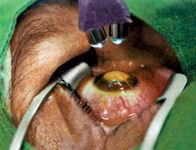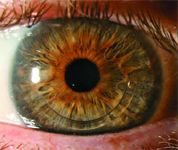Article
Post-LASIK ectasia management circumvents need for keratoplasty
Successfully managing progressive post-LASIK corneal ectasia can circumvent the need for keratoplasty. This article describes one technique.

Key Points
A 46-year-old male attorney with high myopia had undergone LASIK in the left eye 5 years previously to correct –10.00 D of myopia. The procedure was complicated by flap striae that required lifting and suturing of the flap to stretch out and minimize the striae. Following those procedures, best-corrected vision in the left eye was 20/30.
Three years later, the patient underwent an enhancement procedure in his left eye to correct a residual –3.50 D of myopia. During the procedure, total corneal thickness, as measured by ultrasound pachymetry, was found to be 476 μm. The flap thickness measured 151 μm, and the residual bed after 61 μm of excimer laser ablation was calculated (not directly measured) to be 265 μm. In the immediate postoperative period, a best spectacle-corrected visual acuity (BSCVA) of 20/30 was attained.

In the right eye, the patient had undergone previous retinal detachment repair, placement of a phakic refractive iris-supported IOL, and subsequent cataract and phakic IOL extraction with placement of a posterior chamber IOL. BSCVA in that eye also was limited to 20/40 secondary to the myopic macular degenerative changes. No topographic evidence of corneal ectasia existed in the right eye.
As a result of the decreased vision in both eyes, the patient began to experience difficulty functioning as an attorney and driving. He sought additional consultation with other corneal and retinal specialists. They recommended either penetrating keratoplasty and or cataract/IOL surgery for the left eye.

The patient elected to proceed with the C3-R/implant procedure. He underwent 30 minutes of UV-light irradiation to the cornea while the cornea, with intact epithelium, was bathed with a riboflavin-impregnated gel. A single 0.35-μm corneal ring was placed in the inferior cornea.
Following the C3-R/implant procedure, VA in the left eye improved from 20/60 to 20/50, with some overall flattening of the central cornea. The patient continued to perceive visual halos and starbursts, and he demonstrated significant higher-order aberrations (HOAs) (total higher-order root mean square [RMS]), predominantly consisting of coma and trefoil.
Over the subsequent 3 months, no indication of any change in the corneal topographic contour was seen on serial comparative corneal topographic assessment. The lack of demonstrable topographic change was interpreted as evidence that the C3-R treatment had stabilized the progression of corneal ectasia by virtue of crosslinking the corneal collagen.





